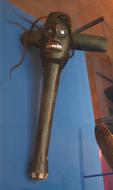Subject: warrior
Culture: Kwakuitl
Setting: Pacific Northwest Coast late 18th-mid 19thc
Evolution:
Context (Event Photos, Primary Sources, Secondary Sources, Field Notes)
* von Aderkas/Hook 2005 p6
"The Kwakiutl lived on northern Vancouver Island and the adjacent mainland of British Columbia. They were a forceful tribe, especially the Lekwiltok, who were feared all the way down to the Lower Columbia. They had guns by 1792, and pushed the Comox Salish out of Cape Mudge, a narrow strait through which all northerners had to pass to reach Fort Victoria. This gave the Lekwiltok an excellent ambush spot for canoe parties heading to the fort. The Kwakiutl had a highly developed ceremonial life that reflected their warlike nature. When intertribal warfare died out in the mid-19th century they modified the potlach, a gift-giving ceremony, into a competitive and aggressive way to humiliate their enemies."
* Boas 1966 p106
"The chief had a number of warriors who obeyed his orders. Often the younger brother of the chief was his warrior, and, at the same time, the head warrior. Warriors were generally disliked and feared by the rest of the people. They were taught to be cruel and treacherous and to disregard all the rules of decent social behavior. A boy who was being trained to become a warrior was treated roughly by his father, who instructed him to insult and maltreat boys and to seduce girls. He was carefully trained in running, swimming, dving, and in the use of weapons of war. They strengthened themselves by bathing in very cold weather. The warrior had no soft bed. He never accumulated stores of provisions. Therefore, notwithstanding the property that he acquired by plunder, he could not maintain a family. Many warriors never married.
"Warriors walked with stiff, jerky motions (t!E'wxa), expressive of their ill humor. They had to avoid laughing. Their right shoulder was always free so that they were ready for a fight. They carried stones in their hands with which they attacked people who displeased them."
* von Aderkas/Hook 2005 p24
"Haida canoes were said to have raided as far south as Cape Mendocino, California, and new research suggests that Kwakiutl canoe parties may also have raided that far south. A branch of the Kwakiutl, the Lekwiltok, were highly aggressive headhunters, raiding the other coastal peoples for their grim trophies. They also headhunted to honor their dead; as soon as one of their tribe died, a canoe party paddled to a neighboring village to kill someone of equal rank, or several people of inferior rank, in an act that was called 'Let someone else wail.'"
Headdress
* Boas 1966 p107
"After a warrior had killed several enemies, he was allowed to wear grizzly bear claws on a headdress (bā'bak!waxgămēε). They also wore caps made of scalps."
Ornaments
* Boas 1966 p106
"Warriors and young men who wanted to become warriors rubbed the body with snake's blood. They wore snake skin around the neck. On this neckband they wore a small pouch containing toes of the lizard, toad, and frog, and a piece taken from a corpse."
Armor
* Boas 1966 p105
"Armor (L!pē'tsaε) was made of dressed elk skin (alā'g.Em). They do not remember having used helmets or armor made of rods."
* von Aderkas/Hook 2005 p45 (reconstructing a Kwakiutl warrior, 19thc)
"The Kwakiutl were fierce headhunters, and greatly feared along the southern coast. This warrior, his face blackened with charcoal, has tied his hair up with bark strips to make it harder for an enemy to grab it in combat. He wears an armor of coiled rope above a cedar-bark kilt. His weapons are a knife of trade metal with a bone handle, and a war club carved in the shape of a killer whale with a dorsal fin made of stone."
* Paterek 1994 p315
"The men wore an unusual type of armor as shown in a Curtis photograph of a Kwakiutl warrior; strands of rope were bound around the torso and over the shoulders to form a sort of breastplate. A wraparound skirt of woven, shredded cedar bark was worn beneath this. They also made armor from elk hide and from wooden slats. The warrior went barefoot and bareheaded. No shields were mentioned by sources consulted."
Body Art
* Boas 1966 p107
"Before going to war, the warrior or his father would pierce his skin with a sharp bone point. It was believed that if he did not cry from pain he would be successful in war. On account of this custom, warriors had their bodies covered with scars. One warrior, when making a speech, pushed a large awl through his arm, between the ulna and the radius, to show his disregard for pain."
Weapons
* Boas 1966 p105
"Weapons for war were the lance, about one and one-half meters long, made of a single piece of yew wood (sEg.ā'yu); a club of whale bone (kwē'xayu); the stone dagger (nEba'yu or Laxstā'la); the battle-ax (Lâ'yâla); a stone club enclosed in hide, with a short handle provided with a loop, by which it was suspended from the wrist (mElē'gayū); the bone dagger (ts!o'wāyu); and bow and arrows with barbed bone points which made dangerous wounds because they had to be pulled or cut out. They also used the sling (yE'nk.!ayu), which was made of dressed elk skin. Ordinary rounded stones were used with the sling. Lance and sling were said to have been the principal weapons."
* Taylor 2001 p16-17
"[E]laborate wooden clubs were developed by the Northwest Coast tribes, such as the Nootka and Kwakiutl. Exhibiting carvings which not infrequently made reference to tribal mythology, such clubs were more used in the ceremonial context rather than on the battlefield and some were referred to as 'slave killers' (although there is little evidence to suggest that they actually performed that function).
